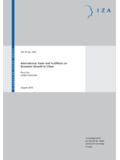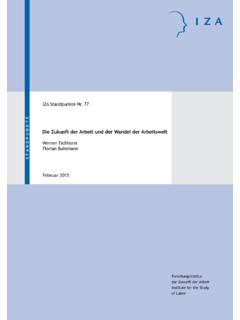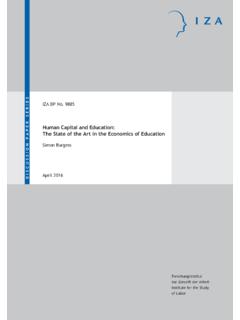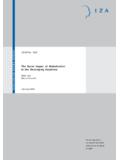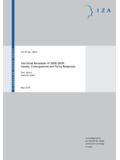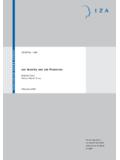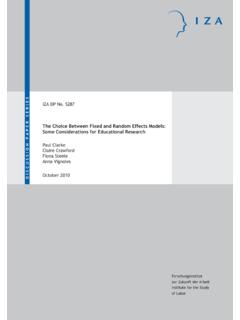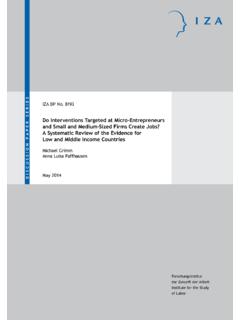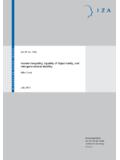Transcription of The Productivity of Working Hours
1 DISCUSSION PAPER SERIESF orschungsinstitut zur Zukunft der ArbeitInstitute for the Study of Labor The Productivity of Working HoursIZA DP No. 8129 April 2014 John Pencavel The Productivity of Working Hours John Pencavel Stanford University and IZA Discussion Paper No. 81 29 April 2014 IZA Box 7240 53072 Bonn Germany Phone: +49-228-3894-0 Fax: +49-228-3894-180 E-mail: Any opinions expressed here are those of the author(s) and not those of IZA. Research published in this series may include views on policy, but the institute itself takes no institutional policy positions. The IZA research network is committed to the IZA Guiding Principles of Research Integrity. The Institute for the Study of Labor (IZA) in Bonn is a local and virtual international research center and a place of communication between science, politics and business. IZA is an independent nonprofit organization supported by Deutsche Post Foundation.
2 The center is associated with the University of Bonn and offers a stimulating research environment through its international network, workshops and conferences, data service, project support, research visits and doctoral program. IZA engages in (i) original and internationally competitive research in all fields of labor economics, (ii) development of policy concepts, and (iii) dissemination of research results and concepts to the interested public. IZA Discussion Papers often represent preliminary work and are circulated to encourage discussion. Citation of such a paper should account for its provisional character. A revised version may be available directly from the author. IZA Discussion Paper No. 8129 April 2014 ABSTRACT The Productivity of Working Hours Observations on munition workers, most of them women, are organized to examine the relationship between their output and their Working Hours .
3 The relationship is nonlinear: below an Hours threshold, output is proportional to Hours ; above a threshold, output rises at a decreasing rate as Hours increase. Implications of these results for the estimation of labor supply functions are taken up. The findings also link up with current research on the effects of long Working Hours on accidents and injuries. JEL Classification: J24, J22, N34 Keywords: Working Hours , output, Productivity , women workers Corresponding author: John Pencavel Department of Economics Stanford University Stanford, CA 94305-6072 USA E-mail: THE Productivity OF Working Hours John Pencavel* I. Introduction In empirical research on measuring the input of labor in production, Hours of work are treatedin different ways. One approach is to neglect work Hours entirely and to measure the input of labor bythe number of employed workers.
4 Another practice is to use worker- Hours , the product of the numberof workers and average Hours per worker, an approach implying that a given proportionate change inthe number of workers has the same effect on the labor input as the same proportionate change inworking Hours per worker. Either of these two ways of proceeding might be correct although it wouldseem worthwhile to ascertain whether it is. As it is, in each recession, calls are made to alleviate unemployment by reducing work hoursamong the employed. After all, if the labor input is simply the sum total of Hours worked by allworkers, so the reasoning goes, this sum can be arrived at if each works fewer Hours and more peopleare employed. Indeed, some governments have applied this reasoning and made changes thatencourage or mandate work-sharing. Another line of research recognizes that changes or differences in Working Hours do not entailthe same changes or differences in effective labor input because individuals tend to work with greaterefficacy at shorter Hours .
5 Economists engaged in growth accounting research took the position thatworkers employed for fewer Hours were more productive during these Hours so that gains in output perhour offset, in part, a shorter Working week. Thus Denison (1962) suggested that, at the level ofworking Hours in 1929 (when weekly Working Hours were 49 Hours averaged over 52 weeks), areduction in Hours would be fully offset in gains that would leave output unchanged. At the hoursprevailing in 1957 (when Hours averaged 40 Hours ), Denison conjectured that a ten percent reductionin Hours would result in a six percent reduction in s conjectures build on a long history of case studies in which a few employers haveinvestigated the consequences of cuts in their employees Working Hours . These can be traced back at* Research assistance from Shirlee Lichtman is gratefully acknowledged. I profited from conversationswith David Card, Avner Greif, and Priya Satia during the preparation of this paper.
6 1 Similar arguments are made by Matthews, Feinstein, and Odling-Smee (1982).2least to Robert Owen s cotton mills in New Lanark in the early nineteenth century. A well-known casewas that at the Salford Iron Works in 1893 where William Mather cut weekly Hours from 53 to though most private employers found reasons to doubt his findings2, Mather deemed it a successas did some government ministers who instituted a shorter Working week in state-managed enterprisesincluding the Woolwich Arsenal Works. In turn, this inspired Ernst Abb at the Zeiss Optical Worksat Jena in Germany to cut the length of the workday from nine to eight Hours . During the first fewdecades of the 20th century, in the United States, the National Industrial Conference Boardcommissioned a number of studies on the effects of shorter Hours . The focus of these and subsequentreviews (such as those of Brown (1965) and Kossoris and Kohler (1947)) was on before and after comparisons: did output fall after a discrete cut in Working Hours ?
7 The results in this paper are basedon more than two observations ( before and after ) on Hours and suggest that the effect on output ofa reduction in Hours depends on the initial level of Working more recent years, economists have estimated aggregate production functions3 in which theeffects of variations in the number of workers are distinguished from the effects of variations in hoursworked per worker. In this paper, the observations on Working Hours are at the level of the place ofwork and production. In addition, the values of Hours studied below extend over a wider range thantypically available. For instance, in Feldstein s (1967) paper on Hours and employment in a Cobb-Douglas production function, Working Hours in 1960 across 24 industries ranged from 41 to 50 hoursper week and the coefficient of variation of Hours is By contrast, the observations examined inSection below range from 24 Hours to Hours per week and their coefficient of variation simple organizing framework is to suppose that, if H i is worker i s Hours of work over aperiod of time and if E i is i s work effort per hour over that period, then i s effective labor input, L i ,may be defined as L i = E i.
8 H i , an expression without empirical content, as yet, because E i isunobserved. If E i is simply a constant, a , then L i = i and worker i s effective labor input is 2 The consensus in private industry was against any reduction in Working Hours and the 48 hourworking week did not become the norm in British industry until 25 years (McIvor(1987, )). Goldmark (1913) provides a good description of some of these early case The aggregation is usually at the level of industries as in Feldstein (1967), Hart and McGregor (1988),Leslie and Wise (1980), or Marti(2000). Hamermesh (1993) reviews this work. 3proportional to his Working Hours and, if i is typical of workers, a firm s effective labor input is the sum of Hours worked over all workers. This would rationalize the use of worker- Hours . More plausibly, i s work effort depends on his Hours of work: E i = f (H i ) where f (H i )embodies the stress, fatigue, monotony, and stimulation that accompanies work.
9 In this event, theoutput- Hours relation depends on the form of f (H i ). If f (H i ) = a 0 + a i where a 0 > 0 and a 1 <0, then L i = a 0 .H i + a i 2 and i s effective labor input rises with Hours worked but at a decreasingrate. If i s effort is a positive quadratic function of Hours , then his effective labor input is a cubicfunction of his Hours , which could justify Denison s conjectures. The research reported below may beinterpreted as an investigation into the shape of f (H i ). A shortcoming of the data studied here is the small number of observations: for scholars whohave become accustomed to research based upon thousands of data points, the research reviewed heremay appear almost anecdotal. Perhaps it is. However, it should be understood that many of the (oftenunobserved to the researcher) differences among workers in contemporary data sets are small whenexamining workers in the same workshop doing the same work. Also, whether anecdotal or not, theseobservations were influential in decisions to reduce Working evidence in this paper on the effect of Working Hours on output is drawn from the researchundertaken by investigators of the British Health of Munition Workers Committee (HMWC) duringthe First World War, the Great War.
10 As described below, this Committee was charged with providingthe Minister of Munitions with advice regarding the health and efficiency of workers in munition plantsand, as part of its investigations, the Committee commissioned studies within munition factories intothe link between work Hours and work performance. In recent years, there have been several usefulreviews of the research conducted within firms,4 but this literature has overlooked the earlier work doneby the investigators of the HMWC and by the subsequent Industrial Fatigue and Industrial HealthResearch Boards. This research almost a century ago on the stressful effects of long Hours of work islikely to be relevant today for certain workers as reviewed below. First, consider the context of theresearch conducted by the HMWC investigators. 4 See Harrison and List (2004) and Bandiera, Barankay, and Rasul (2011). 4 II. The Health of Munition Workers Committee (HMWC) A. The SettingIn 1914, the outbreak of war caused the British government to suspend regulations on workhours in plants producing war-related material.
